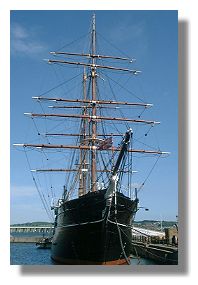
Places to Visit in Scotland
- Discovery Point, Dundee

Background
The first ship used by the Antarctic explorer Captain Robert Falcon Scott was built in Dundee in 1901. In its first expedition to Antarctica it became ice-bound and Scott and the crew were stranded for 26 months. An attempt to reach the South Pole failed but the eventual rescue and the survival made Scott famous. Although he later failed to become the first man to reach the South Pole (he was beaten by the Norwegian Amundsen by just over a month) Captain Scott and his companions, all of whom died on the long march back from the South Pole, became heroic figures. The story of "Scott of the Antarctic" became a legend.In 1985, the city of Dundee offered Discovery a new home. The ship was transported as dry cargo from London and thousands turned out to greet her. Dundee began to be marketed as "The City of Discovery" and a custom built dock and visitor centre was built in the centre of Dundee, on the banks of the river Tay.
RRS Discovery
On March 21st, 1901, the Royal Research Ship named "Discovery" was launched by the Dundee Shipbuilders Company at the Panmure Shipyard in the town. A lot of expertise had been built up in Dundee in creating strong, wooden whaling ships for the local whaling industry and the new ship was further strengthened to force her way through the ice. Although a sailing ship, Discovery was also fitted with a (coal fired) engine.
The captain of the ship was 33-year-old Robert Falcon Scott and there was a hand-picked crew of 10 officers and 36 men (see picture above). After the ship had taken on provisions and equipment for the expedition to the Antarctic, the ship set off on 6 August 1901. After a stop-over in New Zealand, the ship headed for Antarctica, reaching there in January 1902. With the ship anchored in McMurdo Sound, By March the sea ice had closed in and the men settled down to face the long dark winter.
With the return of the southern summer, Scott and two companions (Wilson and Shackleton) set off south with five sledges pulled by teams of dogs. In a gruelling journey in which the men had to pull the sledges over ridges where the dogs were unable to work, they got within 530 miles of the South Pole but had to turn back.
Although a relief ship arrived, the Discovery remained ice-bound despite efforts to free her with dynamite and the expedition faced another winter in the Antarctic. The following summer, two relief ships (whaling ships Morning and Terra Nova) arrived and by February 1904 Discovery had been freed by using controlled explosions to break up the ice.
Scott returned to Edwardian London and told his story to a public eager to hear of the heroic adventure. Scott was obsessed with the idea of becoming the first man to reach the South Pole and returned to Antarctica in 1910 (in the Terra Nova, one of the ships which had rescued him in 1904). The expedition tried using motorised tractors and even ponies instead of dogs but these were not a success. Scott, Wilson, Oates and Evans made the final assault on the pole and reached it on January 18, 1912 only to find that the Norwegian Roald Amundsen had reached it first, less than a month before. On the return journey, during a blizzard, all members of the expedition perished.
Discovery, meantime, was converted to a cargo ship and carried supplies to Hudson Bay in Canada. She later returned to the Antarctic as a research ship but in 1936 she became a training ship for Sea Scouts and as a memorial to Captain Scott. In later years the ship began to deteriorate but a Maritime Trust took over and restoration began. By 1985 the Dundee Heritage Trust offered to bring the ship back to the city of her birth at Victoria Dock. A few years later, she moved to a custom-built dock and became an integral part of "Discovery Point".
Discovery Point
Clearly the RRS Discovery is a major element of the visitor centre. It has been fully restored outside and inside and visitors can wander round the officers' mess deck and cabins, the kitchens, the engine room and storage areas. Models of some of the officers have been placed in some of the rooms to add to the interest. The ship is only 172 feet long from stem to stern and 33 feet across. And these cramped conditions were "home" for 37 men for over three years.
The narrow passageways and steep stairs can make it difficult for those who do not have their "sea legs" even though the ship is moored firmly to the dock. But there is an audio visual presentation on the dockside for those who decide not to venture on board.
The visitor centre has an interesting series of displays with photographs, montages, audio-visual and multimedia presentations, information and actual relics from the Antarctic expedition. One thing it cannot recreate, however, is the intense cold of those Antarctic winters.
There are two fully equipped Education Suites for school parties (one of them is in a converted coal bunker on board the ship). The lavish mahogany panelled officers' Wardroom is available for functions and ordinary mortals can have refreshments in the "Cafe on the Point" which is decorated with original artwork from local artists.
You can find out more about Discovery Point at their Web Site.
Return to the Main Index of Places to Visit
Where else would you like to go in Scotland?

